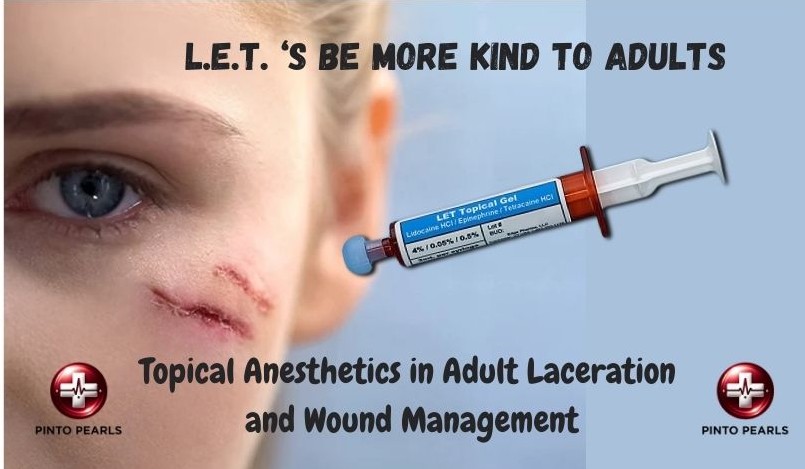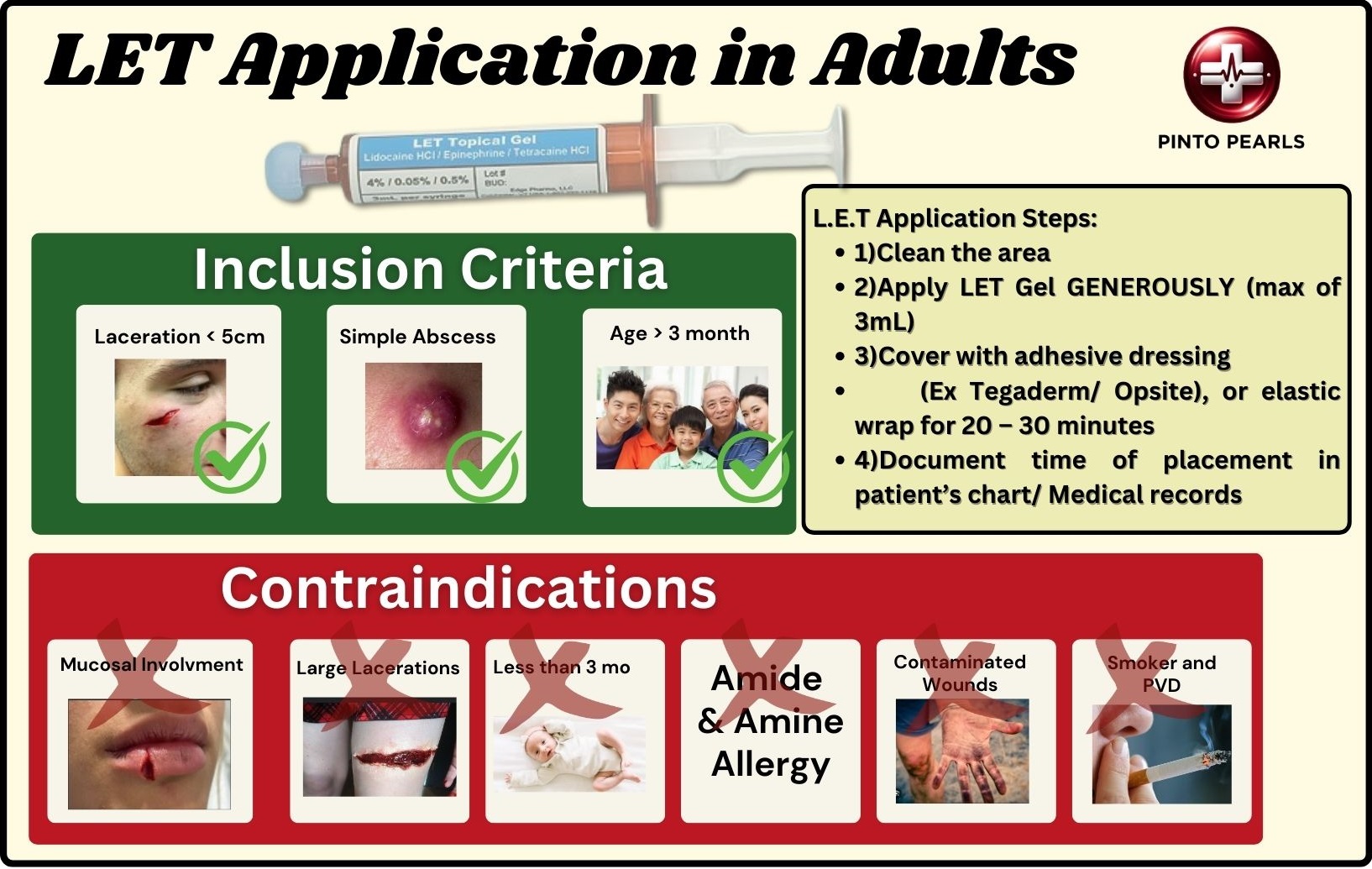

Topical Anesthetics in Adult Laceration and Wound Management
Case:
- 57 yo M comes in with laceration to the face approximately 1cm in length and needs sutures. What is your local anesthetic of choice?
- 25 yo M presents with a paronychia. What is your local anesthetic of choice?
- 38 yo F comes in with an abscess on her back. What is your local anesthetic of choice?
Answer:
In all these cases,
Topical anesthetic, L.E.T
can be used to adequately achieve analgesia AND decrease pain of injection
Hey Doc, Are you recommending us to use L.E.T in ADULTS?? I thought it is only for children?
While historically LET has mainly been used in children, there is no reason why we cannot use it in adults. There is a decrease in pain experienced, decrease in distortion caused by local anesthesia AND doesn’t necessarily increase the amount of time of the procedure.
Recall: LET is a topical anesthetic made up of: lidocaine-epinephrine-tetracaine and CAN be used on open wounds
Hey Doc, how long does it take for LET to work? I don’t have that much time!
For LET to work it needs to be applied about 20 – 30 minutes before doing your procedure. So, ask your nurse at TRIAGE to apply it, or just apply the LET and come back to do your procedure.
Pro tip: LET lasts ~ 45 – 60 minutes AFTER removal, so you have some time even if you get delayed coming back
Typically, you need to wait at least 5 minutes after a lidocaine Injection anyways, so why not decrease pain by trying an injection-free method.
(See below for Triage Protocol)
Will LET provide enough anesthesia for me to actually do my procedure?
YES!! If LET is applied PROPERLY and for the proper DURATION you may NOT need to supplement with injectable lidocaine.
Research has shown that LET on its own provides adequate analgesia in the majority of patients, if properly selected.
Note- even if you DO need lidocaine, the pain with injection is LESS
You are suggesting to use LET for ABSCESS And Paronychia management? I haven’t done that before!
YES! Remember LET anesthetises the skin, and the main reason we give local lidocaine in abscess management is to decrease pain with incision. BUT injecting lidocaine is one of the most PAINFUL aspects of I&D management. SO why not try and decrease pain, topically anesthetize the skin and make the I&D procedure LESS painful!
Note- for paronychias LET needs to be applied longer to ensure adequate penetration.
Yes I have done this, YES it works
Pro-tip: In pediatric patients studies have shown that LET even sometimes helps to spontaneously drain the abscess
What is the best way to apply LET?
- Clean the area
- Apply LET Gel GENEROUSLY (max of 3mL)
- Cover with adhesive dressing (Ex Tegaderm/ Opsite), or elastic wrap for 20 – 30 minutes
- PRO TIP!– Stop applying Gauze!! Gauze Absorbs the LET and prevents it from being absorbed by the skin.
- If gauze MUST be used (to contain the gel), use only a SMALL amount- ie only 1 2×2
- Document time of placement in patient’s chart/ Medical records
- Note: Duration of action of anesthetic is ~ 45 – 60 minutes AFTER removal of anesthetic.
- PRO-TIP! – The white blanching of the skin helps to indicate where the LET was applied and the boundaries of your anesthesia
What are situations where I cannot use LET?
L.E.T has been extensively studied in children and has been considered safe up to 3mL of LET gel without any reported serious adverse effects. [70].
Contraindications:
- Lacerations of Mucous membranes – Ex Lips, or Vulva regions
- LARGE lacerations (> 5 cm)
- Patients with Allergy to amide or ester topical anesthetics
- Grossly contaminated wounds
- Use in caution in infants less than 1 month of age:
- Higher potential for systemic absorption in neonates and the theoretical risk of methemoglobinemia posed by the tetracaine component
- Note that the amount of systemically absorbed lidocaine and tetracaine is actually LESS than calculated amount because of the presence of epinephrine, and if 3mL or less is used, risk for lidocaine toxicity is minimal
Hey Doc- you are Using LET on Finger tips and Nose?? What about the epinephrine
YES, LET CAN be used. Remember we DEBUNKED the myth that Epinephrine cant be used on fingertips, nose ears etc. As long as the vascular supply is fine, (ie no history of significant peripheral vascular disease etc) go ahead, Use LET!
Can LET be implemented at TRIAGE?
YES!!
In fact, many hospitals are starting to have standing orders or triage protocols for LET application
An example of a standing order can be:
Eligible patients
- Age >3 months and weight >5 kg
- Simple lacerations <5 cm in length
- Simple Abscess
Contraindications
- Lacerations of mucous membranes (eg, lip, vulva)
- Large lacerations (> 5 cm)
- Patient known to be a significant smoker or history of peripheral vascular disease
- Grossly contaminated wounds
- Patients with allergy to amide or ester local anesthetics
- Age < 3 month
Procedure
- Clean the area
- Apply LET Gel GENEROUSLY (max of 3mL)
- Cover with adhesive dressing (Ex Tegaderm/ Opsite), or elastic wrap for 20 – 30 minutes
- Document time of placement in patient’s chart/ Medical records

Summary:
- LET can be used in adults and should be used MORE often
- LET decreases the need for needle infiltration and decreases the amount of pain experienced
- LET can be applied at triage (see above for appropriate protocol)
- USES for LET can be expanded to abscess and paronychia management
TAKE HOME POINT:
LETS be kinder to adults, They ARE just big children anyways,
So why not decrease their pain?!
References/ Further Reading
- Adler, Adam J., et al. “Does the use of topical lidocaine, epinephrine, and tetracaine solution provide sufficient anesthesia for laceration repair?” Academic Emergency Medicine, vol. 5, no. 2, Feb. 1998, pp. 108–112, https://doi.org/10.1111/j.1553-2712.1998.tb02593.x.
- C Hsu, Deborah. “Clinical Use of Topical Anesthetics in Children.” UpToDate,. Accessed 15 June 2024.
- Otterness, Karalynn, and Adam J Singer. “Updates in emergency department laceration management.” Clinical and Experimental Emergency Medicine, vol. 6, no. 2, 8 Apr. 2019, pp. 97–105, https://doi.org/10.15441/ceem.18.018.
- Poulton, Theodore, et al. “Anaesthetic management of subcutaneous abscesses: Current status.” British Journal of Anaesthesia, vol. 125, no. 2, Aug. 2020, https://doi.org/10.1016/j.bja.2020.03.018.
- Singer, Adam J, and Mary Jo Stark. “Pretreatment of Lacerations with lidocaine, epinephrine, and tetracaine at triage: A randomized double‐blind trial.” Academic Emergency Medicine, vol. 7, no. 7, July 2000, pp. 751–756, https://doi.org/10.1111/j.1553-2712.2000.tb02262.x.
- Stella Yiu, MD. “Trick of the Trade: Topical Anesthetic Cream for Cutaneous Abscess Drainage in Children.” ALiEM, 11 July 2019

